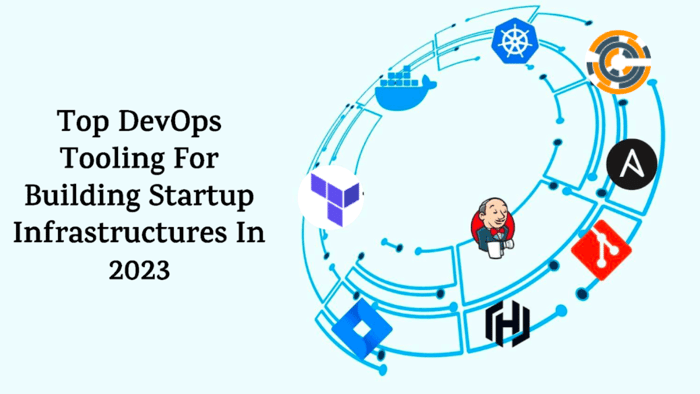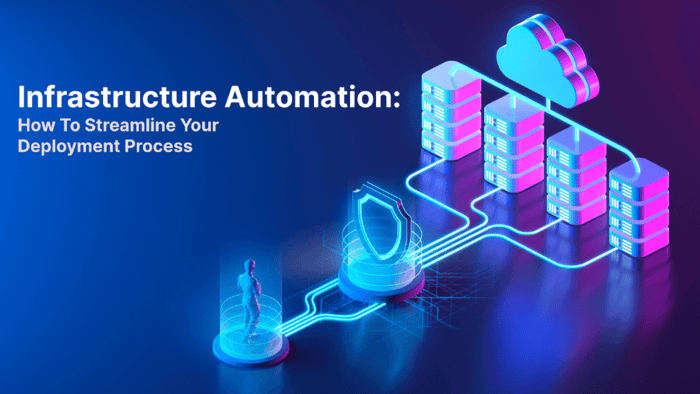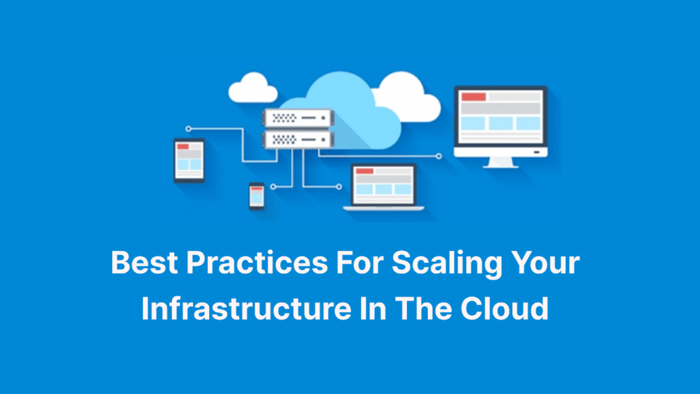DevOps tools for building and managing startup infrastructures for high-quality software delivery in 2023.
Introduction
In today's fast-paced digital landscape, enterprises and startups alike must deliver high-quality software applications and services swiftly and reliably to stay ahead of the competition. This is where DevOps comes into play, as a set of practices that amalgamate software development and IT operations, enabling seamless collaboration and continuous delivery of software. With the rapid growth of cloud computing and containerization, DevOps has evolved into a crucial component of building infrastructures for both established businesses and emerging startups.
DevOps has already revolutionized the way companies function and has become a driving force behind successful startups. For instance, Netflix, the popular streaming service, has embraced DevOps to enable continuous delivery of its services to millions of users worldwide. They have achieved this feat through the implementation of a comprehensive CI/CD pipeline, containerization, and automation.
In this article, we will delve into the top DevOps tools that can help you construct and manage your infrastructure in 2023, catering to enterprises and startups alike. By adopting these tools, you can streamline your development process, reduce manual errors, and accelerate software delivery, providing your organization with the competitive advantage it needs to thrive.
Prerequisites
Before delving into the core of this article, it's crucial to ensure you have a solid foundation in the prerequisites listed below, as you'll need them to effectively utilize these tools.
-
DevOps principles and practices: These encompass practices such as automation, continuous integration, and continuous delivery. They promote collaboration and communication between development and operations teams.
-
Cloud computing knowledge: Understanding the delivery of computing services—including servers, storage, databases, networking, software, analytics, and intelligence—over the internet is essential.
-
Familiarity with Infrastructure as Code (IaC): This practice enables you to manage your infrastructure using code instead of manually configuring hardware devices and operating systems. Consequently, you can automate the process of setting up and managing your infrastructure, making it more efficient and manageable for both startups and enterprises.
Automation and Continuous Integration/Continuous Delivery (CI/CD)
Automation is a vital component of DevOps, as it helps minimize manual errors and enhance delivery speed. Continuous Integration (CI) and Continuous Delivery (CD) are two practices commonly employed in DevOps to automate the software delivery process.
CI entails consistently merging and testing code changes in a shared repository, ensuring the code is always functional and ready for deployment. Meanwhile, CD involves automatically deploying code changes to production after passing all requisite tests.
As illustrated in the image above, a typical CI/CD pipeline comprises several stages, from development to production. Let's break down the different stages:
-
Code Development: The initial stage is where developers write the code that will ultimately become the software. This code is generally stored in a version control system, such as Git.
-
Code Commit: Developers commit the written code to the version control system, triggering the pipeline to initiate the CI/CD process.
-
CI Pipeline: The Continuous Integration (CI) pipeline represents the first part of the CI/CD process and typically consists of the following stages:
-
Build: During the build stage, the code is compiled and packaged into an executable format, ensuring it can run on various environments.
-
Unit Test: Unit tests are automated tests verifying the functionality of small code segments, ensuring each part functions as intended.
-
Integration Test: Integration tests are automated tests that confirm the functionality of different code parts working in conjunction. This ensures seamless operation.
-
-
CD Pipeline: The Continuous Delivery (CD) pipeline constitutes the second part of the CI/CD process, usually comprising the following stages:
-
Review: The review stage involves manual or automated code reviews, ensuring the code meets quality standards and is deployment-ready.
-
Staging: During staging, the code is deployed to a staging environment, which resembles the production environment but serves testing purposes.
-
Production: The production stage is where the code is deployed to the live environment, with which end-users will interact.
-
Numerous tools are available for automating the CI/CD pipeline, with some of the most popular ones include:
-
Jenkins: An open-source automation server used for building, testing, and deploying software. It offers over 1500 plugins supporting various DevOps practices and integrates with numerous tools and services.
-
CircleCI: A cloud-based CI/CD platform supporting many programming languages and frameworks. It provides quick build times, scalable infrastructure, and adaptable workflows to help automate your software delivery process.
-
Travis CI: A cloud-based CI/CD platform supporting multiple programming languages and integrating with various cloud services. It offers a straightforward setup process, swift feedback loops, and customizable build environments to streamline your software delivery process.
With these tools, you can automate your software delivery process, minimize manual errors, and enable the swift and reliable delivery of high-quality software applications and services to users.
Containerization and Orchestration
Containerization is a method of packaging software into a standardized unit for deployment. Containers provide a lightweight and portable environment for running applications. Container orchestration is the process of managing and scaling containerized applications.
The image above illustrates the containerization and orchestration process between any container orchestration tool and distributed application environments/containers. Let's examine each stage:
-
Configuration: The first step in containerization and orchestration is configuring the container environment, which involves defining the software requirements, dependencies, and resources needed for the application to run smoothly. This configuration is typically stored in a Dockerfile or similar configuration file.
-
Availability: The next step is ensuring the container environment is available and accessible for use. This involves deploying the container to a platform or cloud provider and ensuring it is properly configured and set up.
-
Provisioning: Once the container environment is available, the next step is provisioning the resources needed to run the application. This includes allocating CPU, memory, storage, and network resources to the container.
-
Scaling: As application demand increases, it's crucial to scale the container environment to handle the load. Container orchestration tools like Kubernetes automate this process by automatically scaling up or down based on resource usage and demand.
-
Automation: Streamlining the deployment and management of containerized applications requires automation, which involves using tools and scripts to automate tasks such as deployment, configuration, and scaling.
-
Resource Allocation: Container orchestration tools like Kubernetes can dynamically allocate resources to containers based on demand, ensuring the application has the resources it needs to run efficiently without wasting resources.
-
Load Balancing: To ensure traffic is evenly distributed across multiple containers, load balancing is employed. This ensures that no single container is overwhelmed with traffic and that the application remains available and responsive.
-
Health Monitoring: To ensure the container environment and application remain healthy and responsive, health monitoring is employed. This involves monitoring resource usage, performance metrics, and other key indicators to ensure the application is running as expected. If issues are detected, alerts can be generated, and corrective action can be taken.
There are three popular tools that can help you with containerization and orchestration:
-
Docker: the most popular containerization tool that can be used to package applications and their dependencies into a container image. Docker provides a consistent environment for running applications across different machines and operating systems, making it easier to manage and deploy applications.
-
Kubernetes: a popular container orchestration tool that automates the deployment, scaling, and management of containerized applications. Kubernetes provides many features, such as automatic load balancing, horizontal scaling, and self-healing, making it a powerful tool for managing containerized applications. It is also a very good tool as it integrates with many other DevOps tools and services.
-
OpenShift: a popular container application platform that is built on top of Kubernetes. OpenShift provides additional features such as built-in security, multitenancy, and developer productivity tools, making it a popular choice for enterprise-level container deployments.
By using these containerization and orchestration tools, you can create a consistent and portable environment for running your applications, making it easier to manage and deploy them.
Microservices and Serverless
Microservices architecture is a software development approach where complex applications are broken down into smaller, independent services. These services can be developed and deployed independently, each performing a specific task or function. Microservices communicate with each other through APIs, allowing them to work together to provide a complete solution.
Benefits of microservices architecture include:
-
Improved scalability: Each service can be scaled independently, allowing you to allocate resources more efficiently based on the demands of each service.
-
Faster development and deployment: Smaller, independent services can be developed, tested, and deployed more quickly than monolithic applications.
-
Easier maintenance: Due to their smaller scope, individual services are easier to understand, troubleshoot, and maintain.
-
Increased resilience: A failure in one service does not necessarily cause the entire application to fail, improving overall system reliability.
Serverless architecture, on the other hand, is a cloud computing model where the cloud provider manages the infrastructure and automatically allocates resources as needed. In a serverless architecture, the developer focuses on writing code for the application's functionality without worrying about the underlying infrastructure required to run it.
Benefits of serverless architecture include:
-
Cost efficiency: You only pay for the resources used by your application, eliminating the need to pay for pre-allocated resources.
-
Scalability: Serverless architectures can automatically scale to accommodate fluctuating workloads, enabling your application to handle traffic spikes without manual intervention.
-
Simplified operations: The cloud provider handles infrastructure management tasks, such as provisioning, maintenance, and scaling, allowing developers to focus on writing code and delivering features.
-
Faster time-to-market: With no infrastructure to manage, developers can quickly build, test, and deploy new features and applications.
Microservices and serverless architectures can be used together to create highly scalable and fault-tolerant applications. In this approach, the microservices provide the application's core functionality, while serverless functions can be used to execute specific tasks or functions on demand, without the need to provision and manage servers.
For example, consider an e-commerce application that uses microservices architecture. The application can consist of several microservices, such as a service for product catalog management, a service for order processing, and a service for customer management. Each of these services can be developed, deployed, and scaled independently.
Now, let's say the e-commerce application needs to send an email to the customer when their order is processed. In a traditional architecture, a dedicated server would need to be provisioned to handle this task. With serverless architecture, a function can be created that is triggered when an order is processed, and the function can execute the code necessary to send the email without the need for a dedicated server.
This approach provides a highly scalable and fault-tolerant solution, where services can be developed and deployed independently, and serverless functions can be used to execute specific tasks or functions on demand without the need for dedicated servers.
There are two popular tools that can help you with microservices and serverless architecture:
-
AWS Lambda: a popular serverless computing service from Amazon Web Services (AWS) that allows you to run code without provisioning or managing servers. With Lambda, you can easily create event-driven applications and scale them automatically based on demand.
-
Google Cloud Functions: a serverless computing service from Google Cloud that lets you run code in response to events. It automatically scales to handle high volumes of traffic and provides a flexible pricing model based on usage.
By using these microservices and serverless tools, you can create highly scalable and fault-tolerant applications that are easy to develop and deploy. They can also help you reduce operational costs and improve the overall performance of your applications.
Monitoring and Logging
Monitoring and logging are indeed important practices in DevOps, as they enable the detection and resolution of issues before they impact end users. They are essential for maintaining the reliability, performance, and security of software applications and services. Let's explore the practice of monitoring and logging in more detail:

The chart above shows the order of operation for monitoring and logging in DevOps, let’s break them down:
-
Analysis: The process of examining data to gain insights and understanding into how the system is performing. This can involve a variety of techniques, such as statistical analysis, machine learning, and data visualization. The goal of the analysis is to identify patterns, anomalies, and trends in the data that can help identify areas for improvement or optimization.
-
Monitoring: The practice of collecting data about the health and performance of the system in real time. This can include metrics such as CPU usage, memory usage, network traffic, and application response times. The goal of monitoring is to identify issues and potential problems as they arise so that they can be addressed before they impact the end users.
-
Observability: This is a term that refers to the ability to understand and debug complex systems. It involves collecting data from multiple sources, such as logs, metrics, and traces, and making that data easily accessible and understandable. The goal of observability is to enable engineers to quickly diagnose and fix issues as they arise, by providing a holistic view of the system's performance. Observability is typically achieved using a combination of tools, such as logging platforms like ELK Stack, tracing tools like Zipkin or Jaeger, and metrics platforms like Prometheus or Grafana.
Analysis, monitoring, and observability are essential practices in DevOps that enable teams to proactively identify and address issues in their systems. By using these practices in combination with the right tools, teams can ensure that their systems are performing optimally and delivering high-quality services to their users. There are three popular tools that can help you with monitoring and logging:
-
Prometheus: A popular open-source monitoring tool that collects and stores time-series data. Prometheus provides powerful querying and graphing capabilities, making it easy to visualize and understand the system's performance.
-
Grafana: A popular open-source tool for visualizing and analyzing time-series data. It provides customizable dashboards and alerts, making it easy to monitor the system's health.
-
ELK Stack: A popular logging and analytics platform that includes Elasticsearch, Logstash, and Kibana. Elasticsearch is a search engine that stores and indexes data, Logstash is a data processing pipeline that ingests and transforms data, and Kibana is a data visualization tool that allows you to explore and analyze the data.
-
Datadog: A commercial monitoring and analytics platform that provides full-stack observability and integrates with various tools and services.
These monitoring and logging tools are important to detect and resolve issues before they impact the end-users, thereby improving the overall performance and reliability of your applications.
Conclusion
In conclusion, DevOps is a crucial aspect of building startup infrastructures, and the right tools can make all the difference in the speed and quality of software delivery. In this article, we explored the top DevOps tools for building startup infrastructures in 2023, including automation and CI/CD tools, containerization and orchestration tools, microservices and serverless tools, and monitoring and logging tools.
While these tools can help accelerate software delivery and improve product and service quality, it's important to understand their limitations and potential drawbacks. For example, some of the tools may consume more compute credits than desired, and restoring data from backups may not always be straightforward due to schema changes.
Despite these limitations, by utilizing these tools in combination with best practices in DevOps, startups can set themselves up for success in delivering high-quality applications and services to their users.
Akava would love to help your organization adapt, evolve and innovate your modernization initiatives. If you’re looking to discuss, strategize or implement any of these processes, reach out to [email protected] and reference this post.





